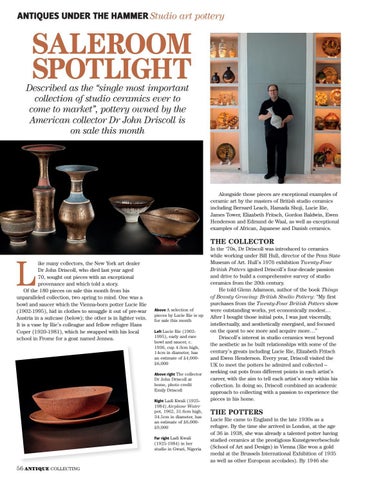ANTIQUES UNDER THE HAMMER Studio art pottery
SALEROOM SPOTLIGHT
Described as the “single most important collection of studio ceramics ever to come to market”, pottery owned by the American collector Dr John Driscoll is on sale this month
Alongside those pieces are exceptional examples of ceramic art by the masters of British studio ceramics including Bernard Leach, Hamada Shoji, Lucie Rie, James Tower, Elizabeth Fritsch, Gordon Baldwin, Ewen Henderson and Edmund de Waal, as well as exceptional examples of African, Japanese and Danish ceramics.
THE COLLECTOR
L
ike many collectors, the New York art dealer Dr John Driscoll, who died last year aged 70, sought out pieces with an exceptional provenance and which told a story. Of the 180 pieces on sale this month from his unparalleled collection, two spring to mind. One was a bowl and saucer which the Vienna-born potter Lucie Rie (1902-1995), hid in clothes to smuggle it out of pre-war Austria in a suitcase (below); the other is in lighter vein. It is a vase by Rie’s colleague and fellow refugee Hans Coper (1920-1981), which he swapped with his local school in Frome for a goat named Jennea.
Above A selection of pieces by Lucie Rie is up for sale this month Left Lucie Rie (19021995), early and rare bowl and saucer, c. 1936, cup 4.3cm high, 14cm in diameter, has an estimate of £4,000£6,000 Above right The collector Dr John Driscoll at home, photo credit Emily Driscoll Right Ladi Kwali (1925-
1984) Airplane Water pot, 1962, 31.6cm high, 34.5cm in diameter, has an estimate of £6,000£9,000
Far right Ladi Kwali (1925-1984) in her studio in Gwari, Nigeria
56 ANTIQUE COLLECTING
In the ‘70s, Dr Driscoll was introduced to ceramics while working under Bill Hull, director of the Penn State Museum of Art. Hull’s 1976 exhibition Twenty-Four British Potters ignited Driscoll’s four-decade passion and drive to build a comprehensive survey of studio ceramics from the 20th century. He told Glenn Adamson, author of the book Things of Beauty Growing: British Studio Pottery: “My first purchases from the Twenty-Four British Potters show were outstanding works, yet economically modest… After I bought those initial pots, I was just viscerally, intellectually, and aesthetically energised, and focused on the quest to see more and acquire more…” Driscoll’s interest in studio ceramics went beyond the aesthetic as he built relationships with some of the century’s greats including Lucie Rie, Elizabeth Fritsch and Ewen Henderson. Every year, Driscoll visited the UK to meet the potters he admired and collected – seeking out pots from different points in each artist’s career, with the aim to tell each artist’s story within his collection. In doing so, Driscoll combined an academic approach to collecting with a passion to experience the pieces in his home.
THE POTTERS Lucie Rie came to England in the late 1930s as a refugee. By the time she arrived in London, at the age of 36 in 1938, she was already a talented potter having studied ceramics at the prestigious Kunstgewerbeschule (School of Art and Design) in Vienna (Rie won a gold medal at the Brussels International Exhibition of 1935 as well as other European accolades). By 1946 she
